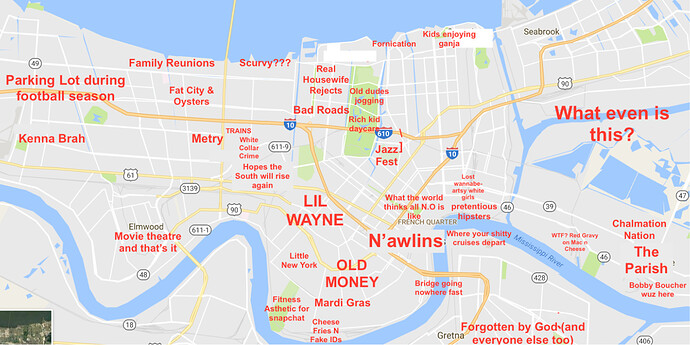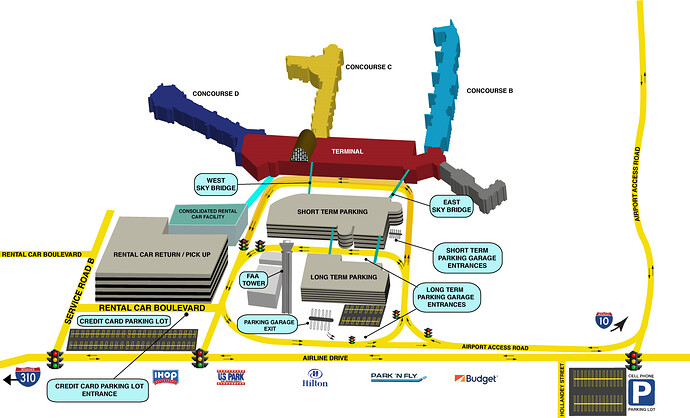Introduction
Driving in cities varies according to each cities geography, social layout, and hot spots. The traffic issues have a major impact on how a city manages its transportation issues, and that is why public transport systems don't cover the needs of the many. This is why rideshare has become so popular since it provides a personalized solution to a time old problem; how do I get from where I am to where I want to be? So here at RSF, I decided to start preparing guides for my readers, comprehensive insights into anything and everything rideshare related.
RSF City Guides for Drivers
This series will look at specific cities and focus on issues that are related to each and every city. Take into account that all information provided will change over time. Cities tend to change their transportation routes, and business, as well as social locations, move around.
New Orleans
New Orleans is a world-famous tourist site, and while it is a relatively small city of only 350,000, it has a large metropolitan area of 1.2 million residents. It is very densely populated with tourists, convention participants, and locals, and is a major US Port. New Orleans came under global coverage when it was severely damaged by flooding in 2005 due to Hurricane Rita.
New Orleans is slightly different from other cities when relating to tourism. The French Quarter is famous (film industry) and is a major foot walking area during the Film Fest when the area from Decatur between Jackson Square and the riverfront is closed to traffic.
Bourbon Street between Canal and St. Ann is also closed during festival times, and that is why knowing your way around as a driver is a key to a successful career in New Orleans. It is also a reason why Lyft and Uber drivers need to explain to visitors that sometimes they need to walk a few blocks to get a ride. For instance, you should ask your client to walk one block from Frenchman St to Elysian Fields; this is the best way to avoid sitting 10 minutes in Frenchman St traffic. Also, asking a passenger waiting on Bourbon Street to meet you either at Dauphine or Royal.
A Look at the New Orleans Areas
A basic fact for good driving is not sitting in traffic, and for the less experienced, sitting for 20 minutes while trying to travel two blocks in the Bourbon district is a classic error for newbies. So, there are a few rules for driving in New Orleans, here is a breakdown of the city:
Broad Street
Another way to avoid the congestion of Claiborne is by taking Broad Street. You can reach uptown by driving away from the river on Poydras and turn on the ramp for Broad Street. You can then use the fork to choose either Napoleon or Fontainebleau to reach all the great places uptown.
Earhart Blvd
As an alternative route to the airport, you can take Earhart Blvd. This road starts to form the end of Calliope and Claiborne and ends at Hickory Drive in Jefferson Parish. Once you get out of the Parish area, the route splits into three lanes and is usually easy to drive on. I always find that taking the I-10 to Airline and then exiting on L and A road is the best way to get to Earhart.
River Road
The best way to get to Jefferson Parish or the airport when uptown is via River Road. You can take River Road all the way to Kenner or try to navigate to Earhart. Either way, it stops you from getting on the interstate which is miles away in the wrong direction.
Washington Avenue
If you are on Carrollton and want to reach, take Washington. This lets you avoid interstate traffic and has less traffic light stops. You will reach Palmetto when using Washington to drive away from the city, and this is a good alternative to the Metairie and Interstate route.
New Orleans Scenes
Since most of the events being held in New Orleans are split into different areas, navigating between the hot spots can be problematic for many. Simply because they are all over the place. Here are the four main locations that you should work in, and preferably focus on when driving a shift.
Tulane/Loyola/Uptown
Uptown is a great place with a lot of demand (surge) on weekdays. Especially during the afternoon the schools start to release all their students. Oak Street is a tight hot spot with a lot of restaurants and student dives. Weekends are great since all the students are out on the town and need rides.
Central Business District (CBD)
This area has two main attractions, hotels and museums. The CBD hosts many conventions and most of the visitors will be residing in this area. A lot of the high-class dining options in New Orleans attract these visitors but are not usually close to the hotels, which means patrons will need a ride.
The museums include The National World War II Museum and The Ogden Museum of Southern Art. Since many tourists stay in various parts of town, you will find a lot of rides ending in the CBD as much as starting from it.
French Quarter/Frenchman Street
This is what everyone thinks is New Orleans, and that's OK. The sexy French Quarter which is constantly filled with tourists but even more so during the French Quarter Festival. Since they like festivals, more and more are becoming a fashion. Just know that driving here is an issue, so find pick-up and drop-off locations that ease you're driving. Also, make sure you have vomit bags for the early morning pickups.
New Orleans International Airport (MSY)
Airports are always a great place to drop off passengers. Picking them up is more of an issue, but since New Orleans is a major tourism town, MSY is not a bad place to wait for customers after making a drop off. Just remember that your Airport sticker is prominently visible.
Amenities
Make sure you have plenty of water in your car, New Orleans is hot, and passengers underrate the effect of the heat due to the humidity. Water is a vital addition to a 5-star rated ride. Also, make sure you have a multi-head mobile device charger, I find that a lot of business visitors, as well as tourists that use their phone cameras, tend to burn up their phone battery fast. Charging in my car is a 24/7 mandatory amenity.
Learn More: Gadgets and Apps to Make Rideshare Driver’s World Smooth
Car Seats and Car Size
Since New Orleans is a tourist town, it is imperative that you have a baby/kid car seat ready for use. Also, if you want a great car choice, try to get an XL or SUV for you rideshare driving. Sometimes you get groups and families that are more than 4 passengers.
Alcohol and Open Containers
While Louisiana law does allow people to walk around with open containers of alcohol. You cannot do so in a car, so make sure that any passenger entering your car seals their alcohol during the ride.
8 tips for safe driving in New Orleans
-
Traffic Lights are not Mandatory
If you think that red means stop, then think again. A lot of drivers here think traffic lights are left over festival decorations, either that or 50% of the drivers are colorblind. Always wait a few seconds, count to three, and never be the idiot that dashes into the intersection just as the lights change, you will end up in hospital. -
Blinkers are Christmas Decorations
Just like traffic lights, most new Orleans drivers think that the car manufacturers added built in Christmas decorations on the car…"ooooh, look, Wilma, mine go blink blink blink." So when you think you can turn safely, or when you see an oncoming vehicle at an intersection, don't rely on logic, or on blinkers, just assume it's a Japanese Zero fighter pilot that thinks WWII is still on. -
Age before Beauty
If you see a geriatric driving their fancy 1950's all dolled up, don't think that driving for 60 years improves their abilities. In fact, Einstein was right, time is relative and the closer you get to 90 years old, the slower you move towards it. Oh, and don't bother to use the horn, they are stone deaf! Just watch an old Mr. Magoo cartoon, and you will get the idea. -
There is no left Turn
Yes, you heard it here, New Orleans is all about going right, being right and "right on." There is no left, and if you want to reach your destination safely, drive to the next intersection, remember to count first, and then turn. -
The One-Way Street City
If you think that there are two-way streets in Louisiana, then think again. This is the "chicken" driving state, where you pay chicken every day on the roads. Two cars, head on, who has the right of way? New Orleans is all about the experience, and as a driver, we experience New Orleans every day. -
Cycling Syndrome
Cyclists have their own global code of conduct. In fact, I think those bicycle helmets come with some kind of global uplink, where all cyclists think they own the road. Be prepared to be cut in front by multi-colored spandex wearing alien. Make sure you have good music and are driving 5 mph. Otherwise, you will need a pacemaker by the time you are 25. -
Relativity
Remember the geriatrics, well speed limits are relative here in New Orleans. In fact, speed limits, like traffic lights are only suggestions, not governed by laws or regulations. Just imagine driving on Earhart at 50 mph, oh shit, why is everyone overtaking me? -
Odd and Weird
New Orleans is all about color and being odd and weird. If you want to stand out get an odd license plate, that way you will be just like 90% of the rest. Or better yet, get a fancy shmancy car all dolled up. You could ask Wrapify to come to town, that would add some color as well as give you some income too.


